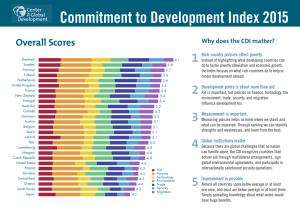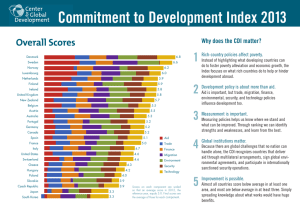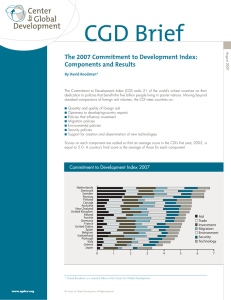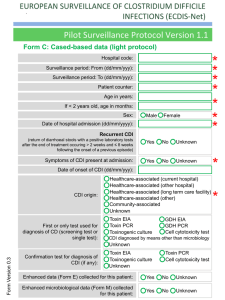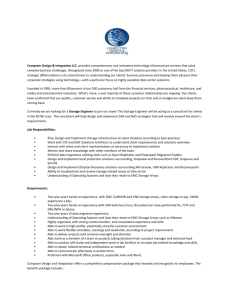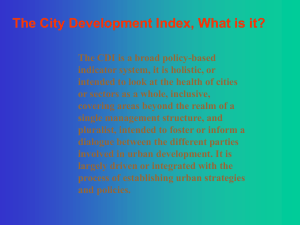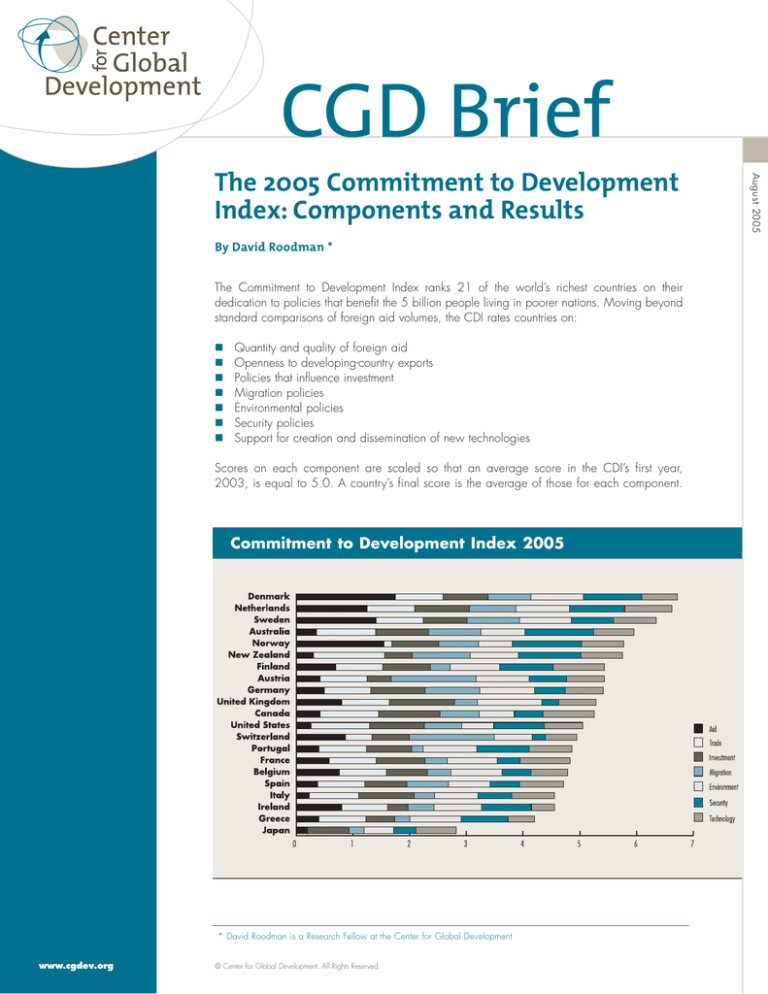
CGD Brief
By David Roodman *
The Commitment to Development Index ranks 21 of the world’s richest countries on their
dedication to policies that benefit the 5 billion people living in poorer nations. Moving beyond
standard comparisons of foreign aid volumes, the CDI rates countries on:
Quantity and quality of foreign aid
Openness to developing-country exports
Policies that influence investment
Migration policies
Environmental policies
Security policies
Support for creation and dissemination of new technologies
Scores on each component are scaled so that an average score in the CDI’s first year,
2003, is equal to 5.0. A country’s final score is the average of those for each component.
Commitment to Development Index 2005
* David Roodman is a Research Fellow at the Center for Global Development
www.cgdev.org
© Center for Global Development. All Rights Reserved.
August 2005
The 2005 Commitment to Development
Index: Components and Results
The 2005 Commitment to Development Index: Components and Results
2
Throughout, the CDI adjusts for size to allow fair comparisons. For example, the U.S. gives much more foreign aid
than Denmark, but far less for the size of its economy, so
Denmark scores higher on this measure. Similarly, U.S.
tariffs on clothing and crops from developing countries do
much more harm than Denmark’s because of the sheer size
of the U.S. market. But since U.S. tax rates on imports are
actually lower, the U.S. scores higher on trade.
The CDI, conceived in partnership with Foreign Policy
magazine, quantifies the full range of rich country policies
that have an impact on poor people in developing
countries. The Index builds on contributions from scholars at
the Center for Global Development, the Brookings Institution,
Georgetown University, the Migration Policy Institute,
the World Resources Institute, and the University of
Colorado. For more information about the CDI, go to
www.cgdev.org.
Why does the CDI matter? In an increasingly integrated
world, rich countries cannot insulate themselves from
global poverty and
insecurity. Poverty and
In an increasingly integrated
weak institutions can
breed global public
world, rich countries cannot
health crises, security
insulate themselves from
threats, and economic
instability
that
can
global poverty and insecurity.
destabilize an entire
region or even the
world. Another reason is fairness. Current trade policy, for
example, places disproportionate burdens on poor
countries. Finally, the index looks at whether countries are
consistent in their values. No human being should be
denied the chance to live free of poverty and oppression
and to enjoy a basic standard of education and health. The
CDI countries, all democracies, preach concern for human
life and dignity within their own borders, and the index
measures whether their policies promote these same
concerns in the rest of the world.
Most comparisons between donors are based on how much aid
each gives, either in absolute terms or as a percentage of GDP.
For the CDI, quantity is merely a starting point in a review that
also assesses aid quality. The index penalizes “tied” aid, which
recipients are required to spend on products from the donor
nation; this prevents them from shopping around and raises
project costs by 15–30%. The index also subtracts debt
payments the rich countries receive from developing countries
on aid loans. And it looks at where aid goes, favoring poor,
uncorrupt nations. Aid to Israel, for example, is counted at 13¢
on the dollar, since Israel is hardly poor. Aid to Mozambique, on
the other hand, with its combination of high poverty and relatively
good governance, is counted at 80¢ on the dollar. Finally,
donors are penalized for overloading recipient governments with
too many small aid projects. When projects are many and
recipient officials few, the obligation to host visits from donor
officials and file quarterly reports becomes a serious burden.
The index rewards governments for letting taxpayers write off
charitable contributions, since some of those contributions go
to Oxfam, CARE, and other nonprofits working in developing
countries. All CDI countries except Austria, Finland, and
Sweden offer such incentives. Since the index is about
government policy, it counts only private giving that is
attributed to tax incentives. Private giving to developing
countries is higher in the U.S. than in most countries, at 10¢
per person per day. But even adding that to the 15¢ a day
in government aid leaves the U.S. well short of donors such
as Sweden and Denmark, which give 72 and 99¢ a day in
government aid alone.
The differences between countries in raw aid quantity are
dramatic, and as a result they heavily influence the overall
aid scores. The Netherlands and the Scandinavian
countries take the top four slots on aid, while Japan and the
U.S. end up near the bottom. But quality matters too.
Denmark earns its big lead on aid by eschewing small
projects. And the U.S. would score higher if it did not tie
70% of its aid and gave less to autocrats in Russia, Jordan,
Pakistan, and other countries.
Aid
Trade
Foreign aid is the first policy that comes to mind when people
in rich countries think of helping poorer countries. Aid donors
give grants, loans, food, and advice to poor countries
to support everything from road building to immunization
programs in tiny villages.
The system of rules that governs world trade has developed
since World War II through a series of major international
negotiating “rounds.” Because rich countries have been
able to call the shots, their barriers to some of the goods
poor countries are best at producing—including crops—
3
Rank Country
Aid
Trade
Investment
Migration
Environment
Security
Technology
Average
1
Denmark
12.3
5.9
5.5
5.3
6.5
7.2
4.4
6.7
2
Netherlands
8.7
5.9
6.8
5.7
6.6
6.8
5.8
6.6
3
Sweden
9.8
5.8
5.5
6.4
6.4
5.2
5.3
6.4
4
Australia
2.5
7.3
6.5
6.5
5.4
8.5
5.0
6.0
5
Norway
10.8
1.0
5.8
4.9
4.2
8.5
5.2
5.8
5
New Zealand
2.1
8.8
3.4
7.1
5.9
7.8
5.1
5.8
7
Finland
4.9
5.8
5.9
2.5
6.1
6.6
6.3
5.4
7
Austria
3.0
5.8
3.0
10.5
6.5
4.7
4.6
5.4
7
Germany
3.4
5.7
6.7
6.8
6.7
3.8
4.7
5.4
10
United Kingdom
5.6
5.9
8.1
2.8
7.9
2.1
4.6
5.3
10
Canada
2.9
7.3
7.6
4.9
4.3
3.5
6.3
5.3
12
United States
1.9
7.2
6.7
4.7
4.0
6.2
4.7
5.0
13
Switzerland
6.0
3.3
4.6
10.5
4.7
1.6
3.8
4.9
13
Portugal
2.8
5.9
5.5
1.4
6.7
6.4
5.3
4.9
15
France
4.1
5.8
6.0
2.7
6.2
2.8
6.2
4.8
15
Belgium
5.4
5.8
5.0
2.9
6.3
3.6
4.5
4.8
17
Spain
2.6
5.8
5.2
5.1
5.1
3.6
5.4
4.7
18
Italy
1.6
6.1
6.8
2.5
5.4
4.1
5.3
4.5
18
Ireland
5.6
5.6
2.5
3.2
5.9
6.1
2.8
4.5
20
Greece
2.8
5.8
3.6
1.8
6.3
5.8
3.2
4.2
21
Japan
1.4
–0.2
5.1
1.8
3.7
2.8
5.0
2.8
High scores
Low scores
have largely stayed in place. Yet when rich countries tax
food imports and subsidize their own farmers’ production,
they cause overproduction and dumping on world markets,
which lowers prices and hurts poor-country farmers.
Industrial tariffs also tend to be anti-poor, with low rates for
raw commodities and high rates for labor-intensive,
processed goods. U.S. tariffs on imports from India,
Indonesia, Sri Lanka, and Thailand brought in $1.87 billion
in 2004—twice the amount the U.S. committed to these
countries for tsunami relief. CGD Senior Fellow William
Cline calculates that if rich countries dropped all remaining
trade barriers, it would lift 200 million people out of poverty.
For the index’s trade component, each country’s complex
collection of tariffs and subsidies is converted into a flat, acrossthe-board tariff representing its total effect on developing
countries. New Zealand does best on trade in the 2005
index, with Australia, Canada, and the U.S. not far behind.
The latter two, along with European Union nations, gained
points in 2005 for keeping a commitment negotiated in 1994
to abolish quotas on textile and apparel imports. In general,
EU nations share common trade and agriculture policies, so
they score essentially the same on trade. Two European nations
outside the EU, Norway and Switzerland, score worse. In last
place is Japan, whose tariffs on rice average 900%.
August 2005
Commitment to Development Index 2005
The 2005 Commitment to Development Index: Components and Results
4
Investment
Foreign investment can be a significant driver of development
in poor countries. Many of East Asia’s fastest-growing
countries—South Korea, Malaysia, Singapore, and
Thailand—benefited from investment from abroad.
However, foreign investment can also breed instability
(witness the 1997 Asian financial crisis) as well as
corruption and exploitation. Angola’s government, which
reaps massive oil revenues from foreign firms, reportedly
“lost” or misspent $4.5 billion in five years, equivalent to
nearly a tenth of its GDP.
The index looks at what rich countries are doing to promote
investment that is actually good for development. It looks at
two kinds of capital flows: 1) foreign direct investment,
which occurs when a company from one country buys a
stake in an existing company or builds a factory in another
country; and 2) portfolio investment, which occurs when
foreigners buy securities that are traded on open
exchanges. The component is built on a checklist of policies
that matter. Do the governments offer political risk
insurance, encouraging companies to invest in poor
countries whose political climate would otherwise be
deemed too insecure? If so, do they filter out projects likely
to do egregious environmental harm or exploit workers?
Do they have tax provisions or treaties to prevent overseas
investors from being taxed both at home and in the
investment country?
The lowest scorers are Austria, which severely restricts pension
fund investments in developing countries, and Ireland and
New Zealand, which do not provide political risk insurance
and do little to prevent double taxation. Top-ranked
Britain does better on all these counts and has participated
aggressively in international arrangements to control
corruption, such as the Kimberley Process to track and
eliminate trade in “blood diamonds” used to finance warlords
in countries such as Angola and Sierra Leone.
foreign aid. Some immigrants from developing countries,
especially students, pick up skills and bring them home—
engineers and physicians as well as entrepreneurs who, for
example, start computer businesses. But emigration to rich
countries has its costs, especially when poor countries lose
skilled workers: it has been blamed for emptying Ghanaian
clinics of nurses, who can earn far more in London hospitals.
The CDI rewards immigration of unskilled people
About 175 million people
more than skilled. One
today—one in 40—live in a
indicator used in the
index is the gross inflow
country different than the
of migrants from develone where they were born.
oping countries in a
recent year, including
unskilled and skilled immigrants but leaving out illegals.
Another is the net increase in the number of unskilled
immigrant residents from developing countries during
the 1990s. The index also uses indicators of openness
to students from poor countries and aid for refugees and
asylum seekers.
Austria and Switzerland tie for first in “importing” the most
labor for their size, especially unskilled labor. At the bottom is
Japan, whose population of unskilled workers from developing
countries actually shrank during the 1990s. The U.S., the
great nation of immigrants, scores a surprisingly mediocre
4.7. Why? Its inflow of legal immigrants is small for its size
and in fact dropped by a third in 2003 as a result of tighter
policies since the September 11, 2001, attacks.
Environment
Migration
A healthy environment is sometimes dismissed as a luxury
for the rich. But people cannot live without a well-functioning
environment. And poor nations have weaker infrastructures and
fewer social services than rich countries, making the results of
climate change—like floods, droughts, and the spread of infectious diseases—all the
more damaging.
Some 175 million people today—one in 40—do not live in
the country where they were born. That number should grow
as aging rich societies run short of workers, which should be
a boon for development. Workers who have migrated from
poor to rich countries already send billions of dollars back
to their families each year. Latin America received $32
billion in remittances in 2003, six times what it received in
The environment component looks at what rich
countries are doing to
reduce their disproportionate exploitation of the
global commons. Are they
reining in greenhouse gas
Climate change would be
more damaging to poor
nations than richer ones
because poor nations have
weaker infrastructure and
fewer social services.
5
CDI Performance over time, using 2005 methodology
Country
2003
2004
2005
Change, 2003–05
1
Spain
4.0
4.4
4.7
+0.7
1
Sweden
5.7
6.2
6.4
+0.7
1
United Kingdom
4.6
4.7
5.3
+0.7
4
Italy
4.0
4.2
4.5
+0.6
5
Portugal
4.4
4.8
4.9
+0.4
5
United States
4.6
4.9
5.0
+0.4
5
Greece
3.8
4.0
4.2
+0.4
5
Canada
4.9
5.1
5.3
+0.4
9
Finland
5.1
5.3
5.4
+0.3
10
France
4.6
4.6
4.8
+0.2
10
Ireland
4.4
4.5
4.5
+0.2
12
Austria
5.3
5.3
5.4
+0.1
12
Norway
5.6
5.7
5.8
+0.1
12
Belgium
4.7
4.5
4.8
+0.1
12
Germany
5.4
5.3
5.4
+0.1
16
Netherlands
6.6
6.7
6.6
+0.0
16
Japan
2.8
2.8
2.8
+0.0
18
Denmark
6.8
6.8
6.7
–0.1
19
Australia
6.2
6.0
6.0
–0.2
19
Switzerland
5.2
4.9
4.9
–0.2
21
New Zealand
6.0
5.7
5.8
–0.3
The data and formulas in the CDI have steadily improved since the first edition in 2003. To judge fairly which countries
have improved most since 2003, this table applies the 2005 CDI formulas to past years. The average CDI score has
climbed a tenth of a point a year since 2003. Several pieces of good news are behind the rise. Greece, Norway,
Switzerland, the United Kingdom, and the United States gave more aid. Canada, the European Union, and the United
States ended quotas on imports of textiles and clothing. Belgium, Denmark, Spain, and Sweden curtailed prohibitions
against pension funds investing in developing countries.
emissions? How complicit are they in environmental destruction in developing countries, for example by importing
commodities such as tropical timber? Do they subsidize fishing
fleets that deplete fisheries off the coasts of such countries as
Senegal and India?
Britain and Germany top the environment standings, in no small
part because they cut their greenhouse gas emissions by 10%
during 1993–2003, the last ten years for which data are
available, thanks to steady increases in gasoline taxes and
strong support for wind and other renewable energy sources.
Most rich countries’ emissions rose. Japan finishes last as a
heavy subsidizer of its fishing industry and a big importer of
tropical timber. It is also the only holdout among CDI countries,
aside from landlocked Switzerland, against the U.N. Fisheries
Agreement, which is meant to limit overfishing in international
waters. The U.S. ratified that agreement but not the Kyoto
Protocol, the most serious international effort yet to deal with
climate change. That gap, along with high greenhouse gas
emissions and low gas taxes, left the U.S. ahead of only Japan.
Security
Rich nations engage daily in activities that enhance or
degrade the security of developing countries. They make or
August 2005
Rank by improvement
The 2005 Commitment to Development Index: Components and Results
6
keep the peace in countries recently riven by conflict, and
they occasionally make war. Their navies keep open sea
lanes vital to international trade. But rich countries also
supply developing-country armed forces with tanks and jets.
The 2005 CDI looks at three aspects of the security-development nexus. It tallies the financial and personnel
contributions to peacekeeping operations and forcible
humanitarian interventions, although it counts only operations
approved by an international body such as the U.N. Security
Council or NATO (thus the invasion of Iraq does not count).
It also rewards countries that base naval fleets where they can
secure sea lanes vital to international trade. Only four
countries get points for that: France, the Netherlands, the
U.K., and the U.S.
Finally, the index penalizes some arms exports to
undemocratic nations that spend heavily on weapons.
Putting weapons in the hands of despots can increase
repression at home and the temptation to launch military
adventures abroad. When weapons are sold instead of
being given to developing nations, this diverts money that
might be better spent on teachers or transit systems. Still,
because countries need guns as well as butter—arming a
police force can strengthen the rule of law—the index
penalizes exports to some countries but not all.
Australia and Norway share the top spot on security—
Australia for its U.N.-approved action in 1999 to stop
Indonesian oppression of East Timor, and Norway for
steady contributions to peacekeeping operations in the
former Yugoslavia and the Middle East. The U.S. scores
above average overall, earning points for flexing its
military muscle near sea lanes but making only average
contributions to approved international interventions and
losing points for its record as a leading arms merchant to
Middle Eastern dictatorships such as Saudi Arabia. Japan
earns a perfect score on arms exports to developing
countries (it has none) but lags otherwise because of its
peace constitution and minimal international military profile.
Technology
One important way that rich countries affect poorer ones
over the long run is through technology transfer. For
example, with medical technology from the rich countries,
human health and survival in Latin America and East Asia
made gains over four decades during the 20th century that
took Europe almost 150 years. Today, the Internet is
facilitating distance learning, democracy movements, and
new opportunities to participate in the global economy. Of
course, some new technologies do as much harm as good,
creating huge new challenges for the developing world:
consider the motor vehicle, which symbolizes gridlock and
pollution at least as much as it does freedom and affluence
in dense and growing cities such as Bangkok.
The index rewards
polices that support
With rich country technology,
the creation and dissemLatin America and East Asia
ination of innovations of
have made the same gains
value to developing
countries. It rewards
in human health in 40
government subsidies
years that took Europe
for research and devel150 years.
opment, whether delivered through spending
or tax breaks. Spending on military R&D is discounted by
half. On the one hand, much military R&D does more to
improve the destructive capacity of rich countries than the
productive capacity of poor ones. On the other, military
security is important for development, and military R&D can
have civilian spin-offs. Consider that the Pentagon partly
funded the early development of the Internet.
Also factored in are policies on intellectual property rights
(IPRs) that can inhibit the international flow of innovations.
These take the form of patent laws that arguably go too far
in advancing the interests of those who produce innovations
at the expense of those who use them. Some countries, for
example, allow patenting of plant and animal varieties. In
such countries, a company could develop a crop variety,
say, that thrives in poor tropical soils, patent it, and then
opt not to sell it because the poor who could use it
have inadequate buying power. Other countries use their
leverage to negotiate trade agreements with individual
developing countries that extend certain IPRs beyond
international norms in the General Agreement on Tariffs and
Trade. U.S. negotiators, for example, have pushed for
developing countries to agree never to force the immediate
licensing of a patent even when it would serve a
compelling public interest, as a HIV/AIDS drug might if
produced by low-cost local manufacturers.
No country does spectacularly better than its peers on
technology. The U.S. loses points for pushing for compulsory
licensing bans, and the Europeans are penalized for
allowing the copyrighting of databases containing data
assembled with public funds. Greece and Ireland lag
The Bottom Line
Denmark comes in first on
to an ample and highquality foreign aid program, steady contributions
to U.N. and NATO
peacekeeping, avoidance
of the international arms
trade, and falling greenhouse gas emissions.
Close behind are two
more big aid donors, the
the 2005 CDI, thanks largely
Even number-one Denmark
scores only about average
(near 5.0) in four of seven
policy areas. All countries
could do much more to
spread global prosperity.
Netherlands and Sweden. Australia takes fourth with a
very different profile: low on aid but strong on trade,
investment, migration, and security. Among the G–7—the
countries that matter most for developing countries by dint of
their economic power—Germany comes in first, followed
closely by the U.K. and the U.S. Japan comes in last on the
index. Like the U.S., its aid program is small for the size
of its economy, and its impact all the smaller when the $4.6
billion that developing countries pay it in debt service is taken
into account. Japan also tends to engage less with
the developing world in ways measured by the index,
with tight borders to the entry of goods and people
from poorer countries and limited involvement in peacekeeping
abroad. Still, even number-one Denmark scores only about average (near 5.0) in four of seven policy areas. All countries could
do much more to spread global prosperity.
For More Information
For the details of the 2005 CGD/FP Commitment to Development Index, see ”The Commitment to Development
Index: 2005 Edition,” by David Roodman, available at www.cgdev.org. The CGD Website contains reports on
each of the index‘s 21 countries, as well as background papers organized by policy area: Roodman on foreign
aid, William R. Cline on trade, Theodore H. Moran on investment, Elizabeth Grieco and Kimberly A. Hamilton on
migration, Amy Cassara and Daniel Prager on environment, Michael E. O‘Hanlon and Adriana Lins de Albuquerque
on security, and Keith Maskus on technology. On the relationship between foreign direct investment and developing
country growth, read Theodore H. Moran, Edward M. Graham, and Magnus Blomstrom, eds., Does Foreign
Direct Investment Promote Development? (CGD and Institute for International Economics, 2005). O‘Hanlon‘s
Expanding Global Military Capacity for Humanitarian Assistance (Brookings, 2003) examines the challenges
to governments preparing to intervene in some ways rewarded by the CDI.
In Trade Policy and Global Poverty (CGD, 2004), Cline puts current international trade negotiations in perspective
with his estimate that complete trade liberalization by rich and poor countries would lift 500 million people out
of poverty. For background on July’s G–8 debt deal, see Nancy Birdsall and John Williamson, Delivering on Debt
Relief: From IMF Gold to a New Aid Architecture (IIE, 2002), Roodman, Still Waiting for the Jubilee: Pragmatic
Solutions for Third World Debt (Worldwatch Institute, 2001), and Todd Moss, Birdsall, and Scott Standley,
Double-Standards, Debt Treatment, and World Bank Country Classification: The case of Nigeria (CGD, 2004).
The Migration Policy Institution and the World Resources Institute, two organizations that significantly contribute
to the Index, are excellent sources of additional information. The World Bank’s new annual, Global Monitoring
Report, is the institution’s first look at what rich countries can do to support development. In Trade Policy
and Global Poverty (Washington: IIE and CGD, 2004), Cline puts current international trade negotiations
in perspective. Materials referenced here are available online at http://www.cgdev.org.
7
August 2005
considerably behind overall because of low government R&D
subsidies. First place is shared by Finland, which spends a
substantial 1% of GDP on government R&D, and Canada,
whose policies on IPRs are the least restrictive of the group.
The
Center for Global Development is an independent, non-partisan, non-profit think tank
dedicated to reducing global poverty and inequality through policy oriented research and active
engagement on development issues with the policy community and the public. A principal focus of
the Center’s work is the policies of the United States and other industrialized countries that affect
development prospects in poor countries. The Center’s
research assesses the impact on poor people
of globalization and of the policies of governments and multilateral institutions. In collaboration with civil
society groups, the Center seeks to identify
policy alternatives that will promote equitable growth
and participatory development in low-income and transitional economies. The Center works with other
institutions to improve
public understanding in industrialized countries of the economic, political,
and strategic benefits of promoting improved living standards and governance in developing countries.
1776 Massachusetts Ave., NW
Third Floor
Washington, D.C. 20036
www.cgdev.org
CGD Brief
The 2005 Commitment to Development Index:
Components and Results
David Roodman
August 2005

